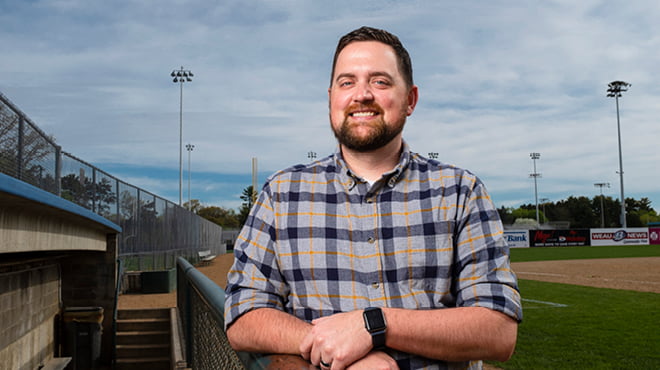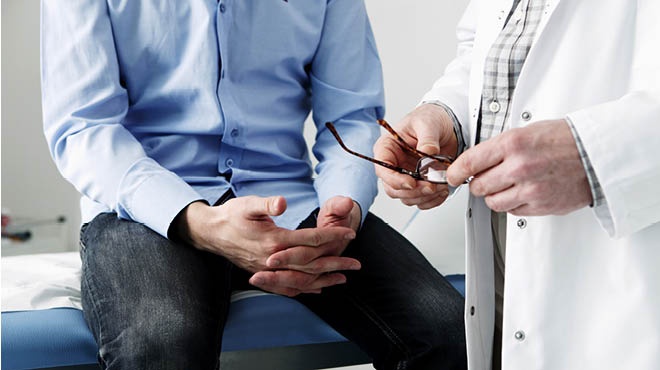Recent Posts
-
 Patient StoriesA lifesaver saved: An EMS veteran’s journey from rescue to recoveryNovember 14, 2025
Patient StoriesA lifesaver saved: An EMS veteran’s journey from rescue to recoveryNovember 14, 2025 -

-

Having surgery safely: Patient undergoes prostate surgery in midst of pandemic

Mark Skrien has a family history of prostate cancer. His father and two uncles were diagnosed during their lifetimes. So he wasn't surprised in February when lab results showed that his prostate-specific antigen (PSA) test, a cancer screening test that looks for signs of prostate cancer, was high.
Mark discussed his lab results and risk factors with his primary care team during his annual physical. Due to his family history and High PSA test result, Mark was referred to urologist Alex Sneiders, M.D., who cares for patients in Owatonna.
Dr. Sneiders explained that Mark would need a biopsy to confirm a diagnosis of prostate cancer. Mark's biopsy was completed on March 19 when he returned from a family vacation to Florida.
A concerning diagnosis
Mark's biopsy confirmed what he had feared: He had an aggressive form of prostate cancer.
"Dr. Sneiders said my tumor was 4 + 5 = 9 on the Gleason scale," says Mark.
The Gleason Score is a 1 to 10 ranking system to determine the aggressiveness of prostate cancer. To his relief, Mark's CT scan results showed that the tumor had not spread but he would need to start treatment soon.
Mark was referred to Matthew Tollefson, M.D., a urologist at Mayo Clinic's Rochester, Minnesota, campus. Normally, this appointment would take place in person, but it was conducted using telehealth technology on March 30 due to the COVID-19 pandemic. He met first with physician assistant Elise Tentis, and then with Dr. Tollefson via Zoom.
"It was fantastic," says Mark. "I could see them on my screen and they could see me. They were very thorough and prepared me for what was going to happen. I got all my questions answered."
The surgical procedure could not take place at that time due to COVID-19. Dr. Tollefson informed Mark that it could be several months before surgery could be completed. He recommended that Mark start with hormone therapy to slow the cancer growth.
“Hormonal therapy is frequently used in prostate cancer as a treatment to sensitize the tumor to radiation and provide a way to avoid more toxic treatment, like chemotherapy, for metastatic prostate cancer,” says Dr. Tollefson.
After hormone therapy, Dr. Tollefson would perform a robot-assisted radical prostatectomy to remove the tumor. During this procedure, Dr. Tollefson would maneuver four interactive robotic arms equipped with surgical instruments to remove Mark's prostate. The robotic device allows a more precise response to movement of the surgeon's hands, reduces blood loss and pain, and results in a faster recovery time.
One of the questions Mark had before surgery was how many prostatectomy procedures Dr. Tollefson had completed.
"Elise Tentis explained that he performs about 300 of these procedures each year and has been doing so for 10 years," says Mark. "That was very reassuring at the time. I knew I was in good hands."
Ready for surgery
The day after meeting with Dr. Tollefson, Mark received the first hormone therapy injection in Owatonna and waited for his surgery to be scheduled. He did not need to wait long, as he received a call just nine days later from Dr. Tanner Miest, chief resident in Urology at Mayo Clinic, Rochester.
"Dr. Miest said that they had a surgery opening on April 15 or 17 and I just needed to pass a COVID-19 test before," says Mark. "I jumped at the chance."
Before the surgery, Mark completed tests in Owatonna and Rochester including an MRI, two CT scans and a bone scan to make sure the cancer had not spread to other areas of his body. He also had a COVID-19 test to determine that he was negative for the virus.
On the morning of April 15, Mark's wife dropped him off at Mayo Clinic in Rochester.
"It was surreal, walking into surgery and looking back to see her waving at the door," says Mark.
Due to visitor restrictions at that time, his wife was not able to accompany him on that day but received updates from the staff throughout the day. Restrictions have since been modified to allow one visitor.
Dr. Tollefson reported that Mark's surgery went well. He remained in the hospital one night. Since returning home, he says he is feeling well during his recovery and walking up to two miles a day. He will return to the Mayo Clinic in three months to repeat the PSA screening. If his levels are in the normal range, Mark does not expect needing any additional treatment.
When reflecting on having surgery during a pandemic, he has high praise for the care team.
"Everyone did a fantastic job in Owatonna and Rochester. I have so many positive thoughts and memories of the staff — from schedulers to nurses and doctors to the staff who served my lunch," says Mark. "In light of COVID-19 and everything, the whole process was done very professionally and safely."
"Prostate cancer treatment and even screening, is very safe today — probably safer than going to the grocery store," says Dr. Tollefson. "Patients should feel reassured that they are entering a very highly screened setting."



